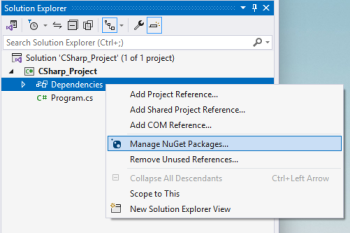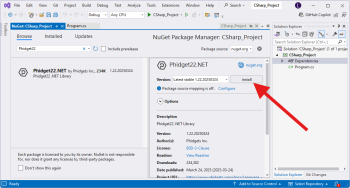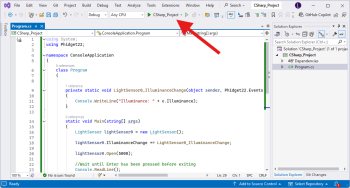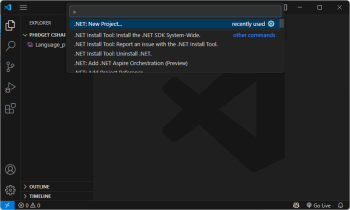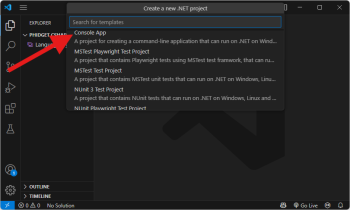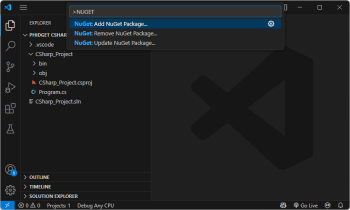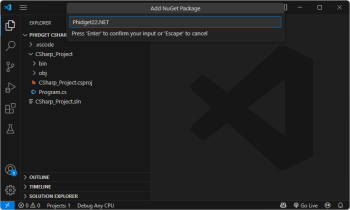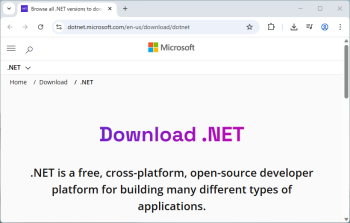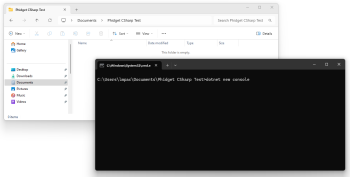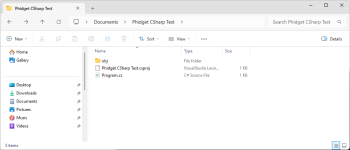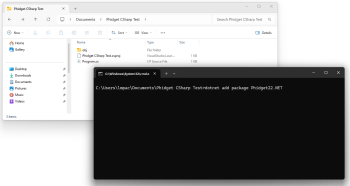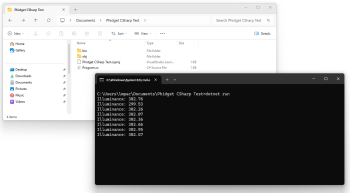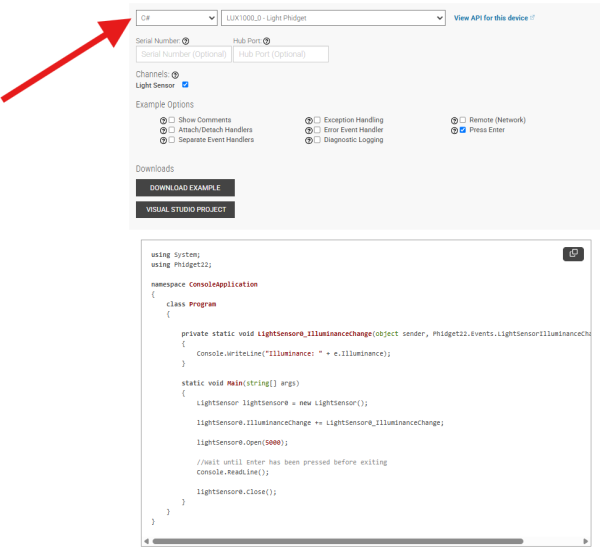|
|
| (178 intermediate revisions by 9 users not shown) |
| Line 1: |
Line 1: |
| [[File:icon-CSharp.png|64x64px|link=Language - C Sharp]]C# is a modern, object-oriented programming language developed by [[http://www.microsoft.com Microsoft]].
| | {{#seo:|description=Learn how to use Phidget USB devices with C#.}} |
| | [[Category:Language]] |
|
| |
|
| __TOC__
| | ==Get Started== |
| | With the Phidget22.NET library, it's easy to create C# applications that work with Phidget devices. |
|
| |
|
| ==Introduction== | | ==C# Libraries== |
| | ===Nuget Package=== |
| | The Phidget22.NET library is available as a [https://www.nuget.org/packages/Phidget22.NET/ nuget package]. This is the recommend way to install and manage the Phidget22.NET library. |
|
| |
|
| {{LanguageSupport|C#|the complete Phidget API, including events|all Phidget devices.|the .NET or Mono framework. Both of the frameworks are supported on Windows. For Linux and Mac OS X, only the Mono framework can be used}}
| | ====macOS Considerations==== |
| | Phidget devices running a HID USB stack require the installation of the macOS libraries or the standalone Phidget Control Panel ([{{SERVER}}/docs/OS_-_macOS download here]). |
|
| |
|
| ==Quick Downloads==
| | To determine what USB stack your Phidget device is on, navigate to the product page and then to the specification tab, and look for the ''USB Stack'' specification. If you are using a VINT device, navigate to the product page for the VINT Hub you are using. |
|
| |
|
| Just need the C# drivers, libraries, and examples? Here they are:
| | [[Image:Javascript_networkserver_webusb_spec.png|center|600px|link=https://cdn.phidgets.com/docs/images/8/80/Javascript_networkserver_webusb_spec.png]] |
|
| |
|
| C# API Documentation:
| | ====Linux Considerations==== |
| *[http://www.phidgets.com/documentation/Phidget21.NET.zip C# API Manual Download] or [http://www.phidgets.com/documentation/web/NETDoc/Index.html (HTML online version)]
| | Linux restricts access to USB devices to the root user. To run your .NET application as a regular user, you'll need to [{{SERVER}}/docs/OS_-_Linux#Setting_udev_Rules set up udev rules] on your system. |
| *[[General API]] (more help on functions common to all Phidgets)
| |
| *[[Device List | Device Specific APIs]] (more help on functions specific to your Phidget)
| |
|
| |
|
| C# Example Code:
| | ===Library Files=== |
| | | If you would like to manually manage the Phidget22.NET library files, you can download them [https://cdn.phidgets.com/downloads/phidget22/libraries/windows/Phidget22-windevel.zip here]. |
| *[http://www.phidgets.com/downloads/examples/CSharp_2.1.8.20110615.zip C# Example Code]
| |
| | |
| Libraries and Drivers:
| |
| *[http://www.phidgets.com/downloads/libraries/phidget21-x86_2.1.8.20110615.zip .NET Framework Files]
| |
| *[http://www.phidgets.com/downloads/libraries/Phidget-x86_2.1.8.20111220.exe 32 bit Windows (drivers, with libraries)]
| |
| *[http://www.phidgets.com/downloads/libraries/Phidget-x64_2.1.8.20111220.exe 64 bit Windows (drivers, with libraries)]
| |
| *[http://www.phidgets.com/downloads/libraries/libphidget_2.1.8.20111028.tar.gz General Linux Libraries] ([[OS - Linux | Linux Library Setup Instructions]])
| |
| *[http://www.phidgets.com/downloads/libraries/Phidget_2.1.8.20111103.dmg General Mac OSX Libraries] ([[OS - Mac OS X | Mac OS X Library Setup Instructions]])
| |
| | |
| ==Getting started with C#==
| |
| | |
| If you are new to writing code for Phidgets, we recommend starting by running, then modifying existing examples. This will allow you to:
| |
| {{ExampleCodeReasons}}
| |
| | |
| Instructions are divided up by operating system. Choose:
| |
| *[[#Windows(2000/XP/Vista/7)|Windows 2000 / XP / Vista / 7]]
| |
| *[[#Mac OS X |Mac OS X]]
| |
| *[[#Linux | Linux]] (including PhidgetSBC)
| |
| | |
| ==Windows(2000/XP/Vista/7)==
| |
| | |
| ===Libraries===
| |
| *[http://www.phidgets.com/downloads/libraries/Phidget21-windevel_2.1.8.20111220.zip .NET Framework Files]
| |
| | |
| ===Description of Library Files===
| |
| We provide direction on how to use the Visual Studio 2005/2008/2010, Visual Studio 2003, Mono and MonoDevelop IDE.
| |
| C# programs on Windows depend on the following files, which the installers above put onto your system:
| |
| * <b><code>phidget21.dll</code></b> contains the actual Phidgets library, which is used at run-time. If you used our installer, it's already placed in <code>C:\Windows\System32</code>. It can be manually installed - check our [[Manual Installation instructions]].
| |
| You will also need one of the following two files, depending on the .NET framework version you are targeting:
| |
| * <b><code>Phidget21.NET.dll</code></b> is the Phidgets library for .NET framework <i><b>2.0</b></i> or higher. Your compiler has to know where this file is. By default, our installer puts this file into <code>C:\Program Files\Phidgets</code>. You can either point your compiler to that location, or copy and link to it in a directory for your project workspace. For more information, please see the section for your specific compiler/environment. If you do not want to use our installer, you can get the file [[#Libraries | here]].
| |
| * <b><code>Phidget21.NET1.1.dll</code></b> is the Phidgets library for .NET framework <i><b>1.1</b></i>. Your compiler has to know where this file is. By default, our installer puts this file into <code>C:\Program Files\Phidgets</code>. You can either point your compiler to that location, or copy and link to it in a directory for your project workspace. For more information, please see the section for your specific compiler/environment. If you do not want to use our installer, you can get the file [[#Libraries | here]].
| |
| You can optionally install the following files:
| |
| * <b><code>Phidget21.NET.XML</code></b> provides the IntelliSense in-line documentation for the .NET library in Visual Studio/MonoDevelop. This documentation is also visible in the Object Browser in Visual Studio. By default, our installer puts this file into <code>C:\Program Files\Phidgets</code>. If you do not want to use our installer, you can get the file [[#Libraries | here]] and place it in the same directory as <code>Phidget21.NET.dll</code>.
| |
| * <b><code>Policy.2.1.Phidget21.NET.dll</code></b> is the policy assembly for <code>Phidget21.NET.dll</code>. Our installer places this file in the Global Assembly Cache(GAC) directory. It directs any programs compiled against version 2.1.0 or higher of <code>Phidget21.NET.dll</code> to use the most recent installed version. If you do not want to use our installer, you can get the file [[#Libraries | here]].
| |
| | |
| Running the examples and writing your own code can be fairly compiler-specific, so we include instructions for each compiler below.
| |
|
| |
|
| | ==Development Environment Configuration== |
| ===Visual Studio=== | | ===Visual Studio=== |
| | {| style="margin:auto;" class="table-no-border mw-collapsible mw-collapsed" |
| | |+ '''Instructions''' |
| | | Create your Visual Studio project, and navigate to the '''Solution Explorer'''. From there, right-click on '''Dependencies''' and select '''Manage NuGet Packages...'''|| [[Image:Language_csharp_vs_managenuget.png|center|350px|link=https://cdn.phidgets.com/docs/images/c/cc/Language_csharp_vs_managenuget.png]] |
| | |- |
| | | Next, click '''Browse''' and enter '''Phidget22.NET''' in the search bar. || [[Image:Language_csharp_vs_browsenuget.png|center|350px|link=https://cdn.phidgets.com/docs/images/6/61/Language_csharp_vs_browsenuget.png]] |
| | |- |
| | | Click on the package and press the '''Install''' button. || [[Image:Language_csharp_vs_installnuget.png|center|350px|link=https://cdn.phidgets.com/docs/images/b/b8/Language_csharp_vs_installnuget.png]] |
| | |- |
| | | Finally, add your C# code and run it using the button at the top of the screen. || [[Image:Language_csharp_vs_run.png|center|350px|link=https://cdn.phidgets.com/docs/images/5/5a/Language_csharp_vs_run.png]] |
| | |- |
| | |} |
|
| |
|
| ====Visual Studio 2005/2008/2010====
| | ===Visual Studio Code=== |
| | | {| style="margin:auto;" class="table-no-border mw-collapsible mw-collapsed" |
| Please start by downloading the C# Examples. While these examples were written in Visual Studio 2005 and 2008, Visual Studio 2010 will easily open and upgrade them.
| | |+ '''Instructions''' |
| *[http://www.phidgets.com/downloads/examples/CSharp_2.1.8.20110615.zip Microsoft Visual C# Examples]
| | | Install the [https://marketplace.visualstudio.com/items?itemName=ms-dotnettools.csdevkit C# Dev Kit extension for Visual Studio Code].|| [[Image:Language_csharp_vscode_installext.png|center|350px|link=https://cdn.phidgets.com/docs/images/b/b8/Language_csharp_vscode_installext.png]] |
| | | |- |
| Microsoft makes free versions of Visual Studio available known as Express Editions. The Express editions are suitable for most applications, but are limited in features for more complex applications. Please see [http://www.microsoft.com/visualstudio Microsoft Visual Studio] for more information.
| | | Next, create a directory and open it in Visual Studio Code. You can do this by opening Visual Studio Code and selecting '''File > Open Folder...''' || [[Image:Language_csharp_vscode_newfolder.png|center|350px|link=https://cdn.phidgets.com/docs/images/4/43/Language_csharp_vscode_newfolder.png]] |
| | | |- |
| =====Use Our Examples=====
| | | Open the Command Palette (Ctrl + Shift + P), type '''.NET: New Project''', and press Enter. A list of supported project types will appear. || [[Image:Language_csharp_vscode_netnewproject.png|center|350px|link=https://cdn.phidgets.com/docs/images/f/f7/Language_csharp_vscode_netnewproject.png]] |
| | | |- |
| To run the examples, you first download them [[#Visual Studio|from above]] and unpack them into a folder. To load all projects in Visual Studio, go to File → Open → Project, and open <code>AllExamples/AllExamples.sln</code> or <code>AllExamples/AllExamples_vs2008.sln</code> for Visual Studio 2005 and 2008, respectively.
| | | Select your preferred project type from the list. For this example, we will select '''Console App'''. || [[Image:Language_csharp_vscode_netconsoleapp.png|center|350px|link=https://cdn.phidgets.com/docs/images/b/bc/Language_csharp_vscode_netconsoleapp.png]] |
| | | |- |
| If you are opening the Phidget examples in Visual Studio 2010, you will need to go through the Visual Studio Conversion Wizard to convert the 2005 or 2008 project.
| | | Next, we need to add the Phidget22.NET library using NuGet. Open the Command Palette again (Ctrl + Shift + P), and enter '''NuGet: Add NuGet package...'''. |
| <br/><br/>[[File:VS2005 Conversion Wizard.PNG]]<br/><br/>
| | || [[Image:Language_csharp_vscode_addnugetpackage.png|center|350px|link=https://cdn.phidgets.com/docs/images/2/26/Language_csharp_vscode_addnugetpackage.png]] |
| | | |- |
| This will load all of the examples available for C#, and then you can set your main project to be the one that matches your device. If you aren't sure what the software example for your device is called, check the software object listed in the [[Device List | Getting Started guide for your device]].
| | | When prompted, enter '''Phidget22.NET''' and install the latest package.<br><br>'''Note''': Ensure you are downloading the latest version which can be seen [{{SERVER}}/?view=changelog here]. Visual Studio Code may incorrectly show an older version as the ''latest'' by default.|| [[Image:Language_csharp_vscode_phidget22net.png|center|350px|link=https://cdn.phidgets.com/docs/images/d/d5/Language_csharp_vscode_phidget22net.png]] |
| | | |- |
| The only thing left to do is to run the examples! Click on Debug → Start Debugging. Please note that the projects, by default try to find the <code>Phidget21.NET.dll</code> in the <code>C:\Program Files\Phidgets</code>. If you have it installed in another location, please change the path to the file's location accordingly. If you are receiving an error message regarding that the namespace Phidgets cannot be found, please re-add the reference to <code>Phidget21.NET.dll</code>. Please see the [[#Write Your Own Code | next section]] for details.
| | |- |
| <br/><br/>
| | | Finally, add your C# code and run it using the button at the top of the screen. || [[Image:Language_csharp_vscode_runcodepng.png|center|350px|link=https://cdn.phidgets.com/docs/images/d/dc/Language_csharp_vscode_runcodepng.png]] |
| [[File:CSharp VS2005 Run.PNG ]] | | |- |
| <br/><br/>
| | |} |
| Once you have the C# examples running, we have a [[#Follow The Examples|teaching section]] below to help you follow them.
| |
| | |
| =====Write Your Own Code===== | |
| | |
| When you are building a project from scratch, or adding Phidget function calls to an existing project, you'll need to configure your compiler / development environment to properly link the Phidget C# libraries. To begin:
| |
| | |
| * Generate a new Visual C# Windows Applications project with a descriptive name such as PhidgetTest.
| |
| <br/>[[File:CSharp VS2005 New Project.PNG ]]
| |
| | |
| <br/>
| |
| | |
| * Add a reference to the .NET Phidgets library.
| |
| <br/>[[File:CSharp VS2005 Add Reference.PNG ]]<br/>
| |
| * Under the .NET tab, select <code>Phidget21.NET.dll</code>.
| |
| If you used our installer, these files are installed in <code>C:\Program Files\Phidgets</code>, by default. If it does not appear in this list, then you can browse to the Phidget Framework installation directory and add the file.
| |
| <br/>[[File:CSharp VS2005 Add Reference 2.PNG ]]<br/><br/>
| |
| | |
| Then, in your code, you will need to include the Phidget library:
| |
| | |
| <div style="background-color: #f3f3f3; border-color: #1c9edb; border-width:1px; border-style: dashed;">
| |
| <font size="3">
| |
| <source lang=cpp>
| |
| using Phidgets;
| |
| using Phidgets.Events;
| |
| </source>
| |
| </font>
| |
| </div>
| |
| | |
| The project now has access to the Phidget21 function calls and you are ready to begin coding.
| |
| | |
| The same [[#Follow The Examples|teaching section]] which describes the examples also has further resources for programming your Phidget.
| |
| | |
| ====Visual Studio 2003====
| |
| | |
| Start by downloading the C# Examples.
| |
| *[http://www.phidgets.com/downloads/examples/CSharp_2.1.8.20110615.zip Microsoft Visual C# Examples]
| |
| | |
| As the examples were written in newer versions of Visual Studio, Visual Studio 2003 is not able to open the examples. Fortunately, you can import the simple examples to a Visual Studio 2003 project. It will be difficult to import the full examples as you will need to recreate the GUI components. In the next section, it will be assumed that the simple examples are used.
| |
| | |
| =====Use Our Examples=====
| |
| Download the examples [[#Visual Studio 2003|from above]] and unpack them into a folder. Here, you can find example programs for all the devices. If you are not sure what the software example for your device is called, check the software object listed in the [[Device List | Getting Started guide for your device]]. You will need this example source code to be copied into your C# project later on.
| |
| | |
| Next, a new project will need to be created.
| |
| * Generate a new Visual C# console application project with a descriptive name such as PhidgetTest.
| |
| <br/>[[File:CSharp_VS2003 New Project.PNG]]<br/><br/>
| |
| | |
| * Add a reference to the .NET Phidgets library.
| |
| <br/>[[File:CSharp_VS2003 Add Reference 1.PNG]]<br/><br/>
| |
| * Under the .NET tab, select <code>Phidget21.NET1.1.dll</code>. If you used our installer, by default, this file is placed in <code>C:\Program Files\Phidgets</code>. If it is in another location, please change the path to the file's location accordingly.
| |
| <br/>[[File:CSharp_VS2003 Add Reference 2.PNG]]<br/><br/>
| |
| | |
| To import the simple example program into your project, please:
| |
| * Open up <code>Class1.cs</code>.
| |
| * Traverse to the example and locate the <code>Program.cs</code> file.
| |
| <br/>[[File:CSharp VS2003 Source Code.PNG]]<br/><br/>
| |
| * Copy and paste the contents from that file into <code>Class1.cs</code>.
| |
| * Comment out the following line as it is not supported in .NET 1.1:
| |
| <div style="background-color: #f3f3f3; border-color: #1c9edb; border-width:1px; border-style: dashed;">
| |
| <font size="3">
| |
| <source lang=csharp>
| |
| using System.Collections.Generic;
| |
| </source>
| |
| </font>
| |
| </div>
| |
| <br/>[[File:CSharp VS2003 Source Code 2.PNG]]<br/><br/>
| |
| | |
| Then, in your code, you will need to include the Phidget library:
| |
| <div style="background-color: #f3f3f3; border-color: #1c9edb; border-width:1px; border-style: dashed;">
| |
| <font size="3">
| |
| <source lang=csharp>
| |
| using Phidgets;
| |
| using Phidgets.Events;
| |
| </source>
| |
| </font>
| |
| </div>
| |
| | |
| The project now has access to the Phidget21 function calls and you are ready to begin coding.
| |
| | |
| Now, you can run the example. Click on Debug → Start.
| |
| <br/><br/>[[File:CSharp VS2003 Run.PNG]]<br/><br/>
| |
| | |
| Once you have the C# examples running, we have a [[#Follow The Examples|teaching section]] below to help you follow them.
| |
| | |
| =====Write Your Own Code=====
| |
| | |
| When you are building a project from scratch, or adding Phidget function calls to an existing project, you'll need to configure your compiler / development environment to properly link the Phidget C# libraries. Please see the [[#Use Our Examples 2 | previous section]] for instructions.
| |
| | |
| ===Mono===
| |
| | |
| This section will provide instructions on how to compile using the <code>mcs</code> compiler. Other compilers such as <code>gmcs</code>, <code>smcs</code>, and <code>dmcs</code> all work in the same way. Start by downloading the C# Examples.
| |
| *[http://www.phidgets.com/downloads/examples/CSharp_2.1.8.20110615.zip C# Examples]
| |
| | |
| =====Use Our Examples=====
| |
| | |
| Download the examples [[#MonoDevelop|from above]] and unpack them into a folder. Here, you can find example programs for all the devices. If you aren't sure what the software example for your device is called, check the software object listed in the [[Device List | Getting Started guide for your device]]. Please only use the simple examples. The full examples uses Windows Forms, which Mono and the Gtk# toolkit are not completely compatible with. Locate the <code>Program.cs</code> file as this contains the example source code. Copy the file into your working directory, and rename it to <code>example.cs</code>.
| |
| <br/> | |
| | |
| To compile and build an executable, run:
| |
| mcs /out:example.exe /lib:"C:\Program Files\Phidgets" /r:phidget21.NET.dll example.cs
| |
| | |
| If you have the <code>Phidget21.NET.dll</code> installed in another location, please change the path to the file's location accordingly.
| |
| | |
| Afterwards, you will have an executable named <code>example.exe</code> that you can run. Place the <code>Phidget21.NET.dll</code> in the same directory as the executable and type the following to run the program:
| |
| mono example.exe
| |
| | |
| Once you have the C# examples running, we have a [[#Follow The Examples|teaching section]] below to help you follow them.
| |
| | |
| =====Write Your Own Code=====
| |
| | |
| When you are building a project from scratch, or adding Phidget function calls to an existing project, you'll need to configure your compiler / development environment to properly link the Phidget C# libraries. Please see the [[#Use Our Examples 3 | previous section]] for instructions.
| |
| | |
| In your code, you will need to include the Phidget library:
| |
| | |
| <div style="background-color: #f3f3f3; border-color: #1c9edb; border-width:1px; border-style: dashed;">
| |
| <font size="3">
| |
| <source lang=cpp>
| |
| using Phidgets;
| |
| using Phidgets.Events;
| |
| </source>
| |
| </font>
| |
| </div>
| |
| | |
| The project now has access to the Phidget21 function calls and you are ready to begin coding.
| |
| | |
| The same [[#Follow The Examples|teaching section]] which describes the examples also has further resources for programming your Phidget.
| |
| | |
| ===MonoDevelop===
| |
| | |
| Start by downloading the C# Examples. These examples were written in Visual Studio 2005 and 2008, but are also compatible with MonoDevelop.
| |
| *[http://www.phidgets.com/downloads/examples/CSharp_2.1.8.20110615.zip C# Examples]
| |
| | |
| =====Use Our Examples=====
| |
| | |
| Download the examples [[#MonoDevelop|from above]] and unpack them into a folder. Here, you can find example programs for all the devices.
| |
| | |
| To run the examples, you first download them from above and unpack them into a folder. To load all projects in MonoDevelop, go to File → Open, and open <code>AllExamples/AllExamples.sln</code>
| |
| | |
| This will load all of the examples available for C#, and then you can set your main project to be the one that matches your device. If you aren't sure what the software example for your device is called, check the software object listed in the [[Device List | Getting Started guide for your device]]. If you are running under the .NET framework, you can use either the full or simple examples. Otherwise, if you are running under the Mono framework, please only use the simple examples. The full examples uses Windows Forms, which is not completely compatible with Mono's Gtk#.
| |
| | |
| <br/>[[File:CSharp MonoDevelop Win Start Up.PNG]]<br/>
| |
| | |
| The only thing left to do is to run the examples! Right click the project, and click on <code>Run With</code> and select the target framework. Please note that the projects, by default try to find the <code>Phidget21.NET.dll</code> in the <code>C\Program Files\Phidgets</code>. If you have it installed in another location, please change the path to the file's location accordingly. If you are receiving an error message regarding that the namespace Phidgets cannot be found, please re-add the reference to <code>Phidget21.NET.dll</code>. Please see the [[#Write Your Own Code 4 | Write Your Own Code ]]section for details.
| |
| | |
| <br/><br/>[[File:CSharp MonoDevelop Win Run As.PNG]]<br/><br/>
| |
| | |
| Once you have the C# examples running, we have a [[#Follow The Examples|teaching section]] below to help you follow them.
| |
| | |
| =====Write Your Own Code=====
| |
| | |
| When you are building a project from scratch, or adding Phidget function calls to an existing project, you'll need to configure your compiler / development environment to properly link the Phidget C# libraries. To begin:
| |
| | |
| * Create a new C# empty project with a descriptive name such as PhidgetTest.
| |
| <br/>[[File:CSharp MonoDevelop Win New Project.PNG]]<br/>
| |
| * Add a reference to the .NET library.
| |
| <br/>[[File:CSharp MonoDevelop Win Reference.PNG ]]<br/>
| |
| * Select <code>Phidget21.NET.dll</code>. If you used our installer, by default, this file is placed in <code>C:\Program Files\Phidgets</code>. If it is in another location, please change the path to the file's location accordingly.
| |
| <br/>[[File:CSharp MonoDevelop Win Reference 2.PNG ]]<br/>
| |
| | |
| Then, in your code, you will need to include the Phidget library:
| |
| | |
| <div style="background-color: #f3f3f3; border-color: #1c9edb; border-width:1px; border-style: dashed;">
| |
| <font size="3">
| |
| <source lang=cpp>
| |
| using Phidgets;
| |
| using Phidgets.Events;
| |
| </source>
| |
| </font>
| |
| </div>
| |
| | |
| The project now has access to the Phidget21 function calls and you are ready to begin coding.
| |
| | |
| The same [[#Follow The Examples|teaching section]] which describes the examples also has further resources for programming your Phidget.
| |
| | |
| ==Mac OS X==
| |
| | |
| C# has excellent support on Mac OS X through the Mono framework.
| |
| | |
| The first step in using C# on Mac is to install the Phidget libraries. Compile and install them as explained on the [[Device List|getting started guide for your device]]. Then, the [[OS - Mac OS X]] page also describes the different Phidget files, their installed locations, and their roles....
| |
| | |
| ==Linux==
| |
|
| |
|
| C# has support on Linux through the Mono framework.
| | ===.NET Command-Line Interface (CLI)=== |
| | {| style="margin:auto;" class="table-no-border mw-collapsible mw-collapsed" |
| | |+ '''Instructions''' |
| | | Download and install the latest version of.NET from [https://dotnet.microsoft.com/en-us/download/dotnet Microsoft's .NET download page].|| [[Image:Language_csharp_cli_download.png|center|350px|link=https://cdn.phidgets.com/docs/images/9/90/Language_csharp_cli_download.png]] |
| | |- |
| | | Next, open a command prompt or terminal in a new folder and enter the following command: |
|
| |
|
| The first step in using C# on Linux is to install the Phidget libraries. Compile and install them as explained on the main [[OS - Linux | Linux page]]. That Linux page also describes the different Phidget files, their installed locations, and their roles.
| | <syntaxhighlight lang=bash> |
| | dotnet new console |
| | </syntaxhighlight> |
|
| |
|
| ==Follow The Examples== | | || [[Image:Language_csharp_cli_newconsole.png|center|350px|link=https://cdn.phidgets.com/docs/images/3/3a/Language_csharp_cli_newconsole.png]] |
| | |- |
| | | This previous command will create a new console application at the folder location. || [[Image:Language_csharp_cli_newproject.png|center|350px|link=https://cdn.phidgets.com/docs/images/c/cb/Language_csharp_cli_newproject.png]] |
| | |- |
| | | Navigate back to the command prompt or terminal, and add the Phidget22.NET package with the following command: |
|
| |
|
| By following the instructions for your operating system and compiler above, you probably now have a working example and want to understand it better so you can change it to do what you want. This teaching section has resources for you to learn from the examples and write your own.
| | <syntaxhighlight lang=bash> |
| | dotnet add package Phidget22.NET |
| | </syntaxhighlight> |
|
| |
|
| Next, comes our API information. These resources outline the C# Phidget functions:
| | || [[Image:Language_csharp_cli_addpackage.png|center|350px|link=https://cdn.phidgets.com/docs/images/7/78/Language_csharp_cli_addpackage.png]] |
| | |- |
| | | You can now open the '''Program.cs''' file and add your code. Run the program by entering the following command into your command prompt or terminal: |
|
| |
|
| {{UsingAPhidgetInCodeGeneral|both of which are available in C#|[http://www.phidgets.com/documentation/Phidget21.NET.zip C# API]}}
| | <syntaxhighlight lang=bash> |
| | dotnet run |
| | </syntaxhighlight> |
|
| |
|
| ===Example Flow=== | | || [[Image:Language_csharp_cli_runcode.png|center|350px|link=https://cdn.phidgets.com/docs/images/f/f3/Language_csharp_cli_runcode.png]] |
| | |- |
| | |} |
|
| |
|
| {{ExamplePseudocode|In C#, you can name these '''event''' functions whatever you like. You will then pass them as function pointers to the Phidget library below in the Main Code section. This hooks them into the actual events when they occur. <br>
| | ==Example Code== |
| In the example code, the event functions common to all Phidgets are called things like '''AttachHandler()''' and '''DetachHandler()''', etc.<br><br>
| | Navigate to our [https://www.phidgets.com/?view=code_samples&lang=CSharp Code Sample Generator] to view and download code samples that are tailored to your specific device. |
| Some event functions will be specific to each device, like when a tag is read on an RFID board, or when a sensor value changes on an Interface Kit.
| |
| Other functions are given in the examples to show you more detail on using your Phidget. For example, '''DeviceInitialize()''' will show what needs to be set up for your Phidget before using it.
| |
| |Creating a Phidget software object in C# is specific to the Phidget. For a Phidget Spatial, for example, this would involve creating a <code>Spatial</code> object. The examples show how to do this and other API functions.<br><br>
| |
| The object provides device specific methods and properties which are available from the API for your specific Phidget.|
| |
| [http://www.phidgets.com/documentation/Phidget21.NET.zip C# API]}} | |
|
| |
|
| ==Code Snippets== | | [[Image:Language_csharp_codesample.png|center|600px|link=https://cdn.phidgets.com/docs/images/0/03/Language_csharp_codesample.png]] |
|
| |
|
| ==Common Problems and Solutions/Workarounds== | | ===Phidget Programming Basics=== |
| | {{PhidgetProgrammingBasicsLink}} |
|
| |
|
| Here you can put various frequent problems and our recommended solutions.
| | ==API== |
| | [{{SERVER}}/?view=api&lang=CSharp Phidget22 API] |


